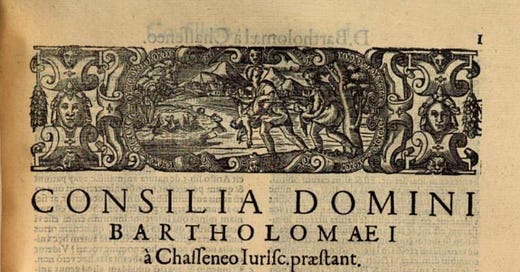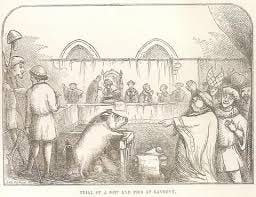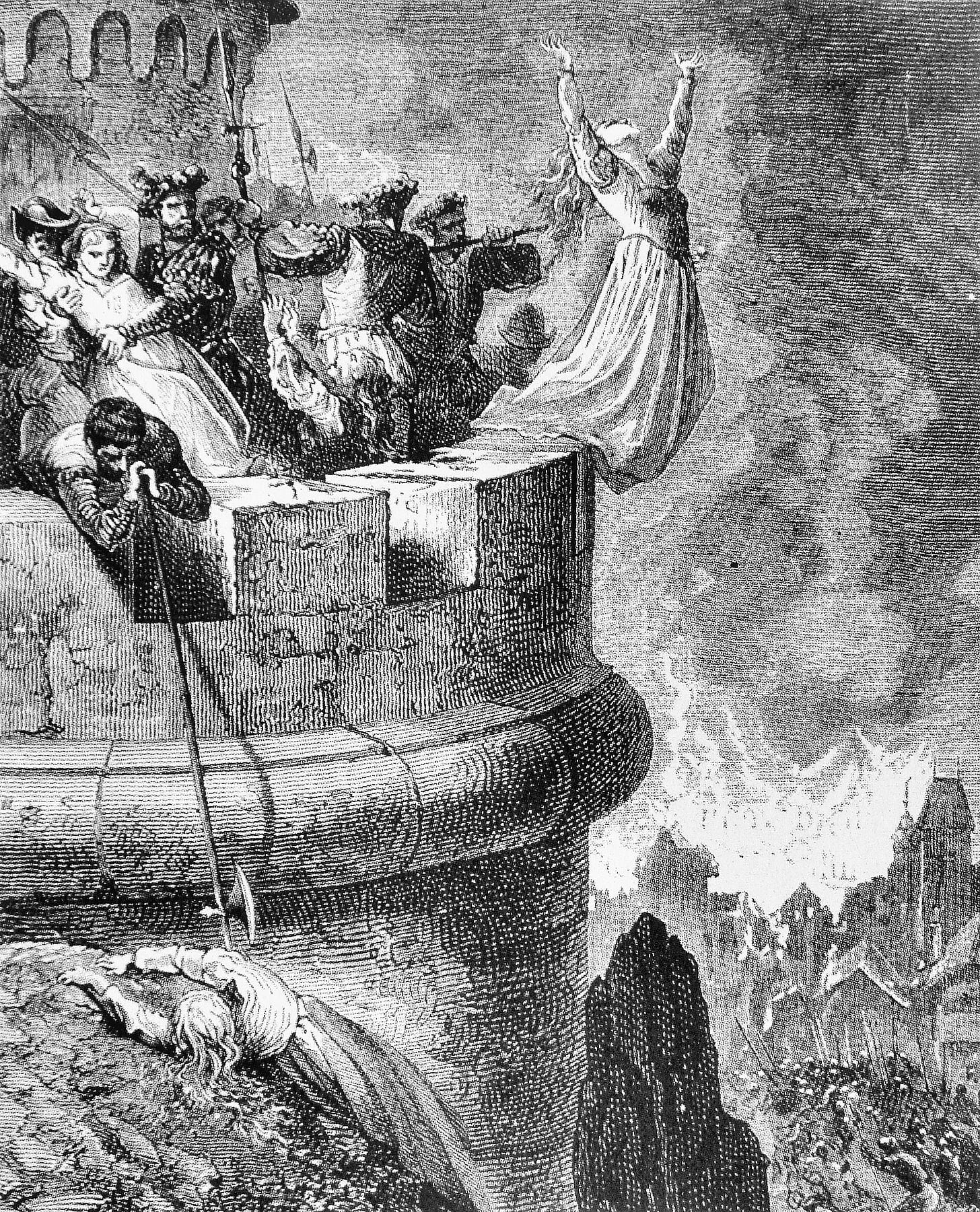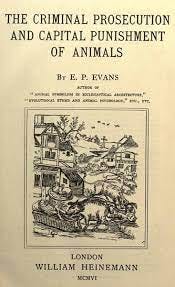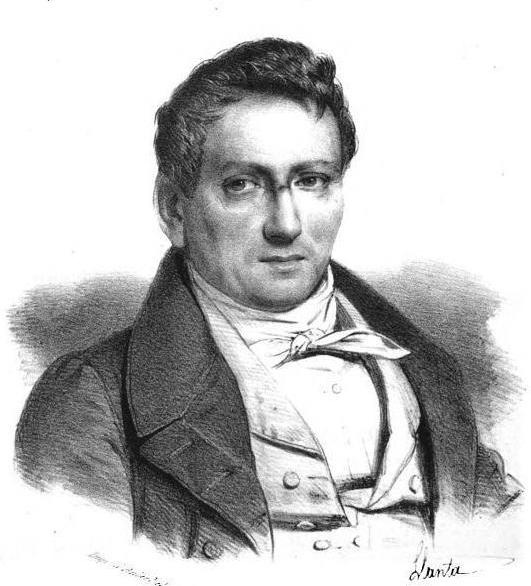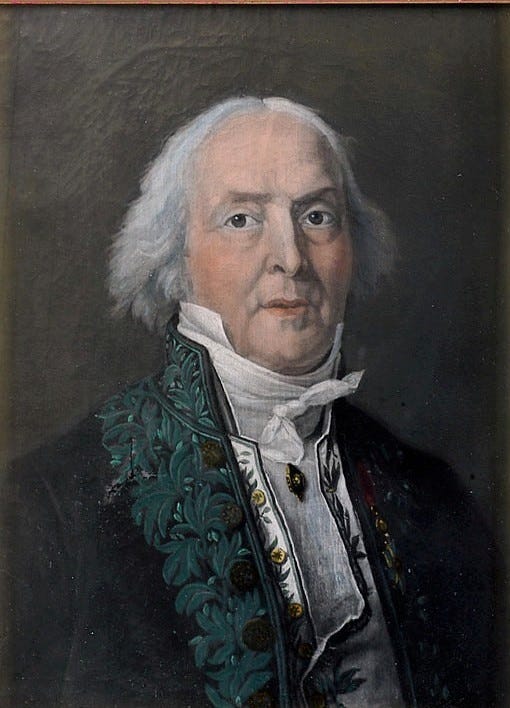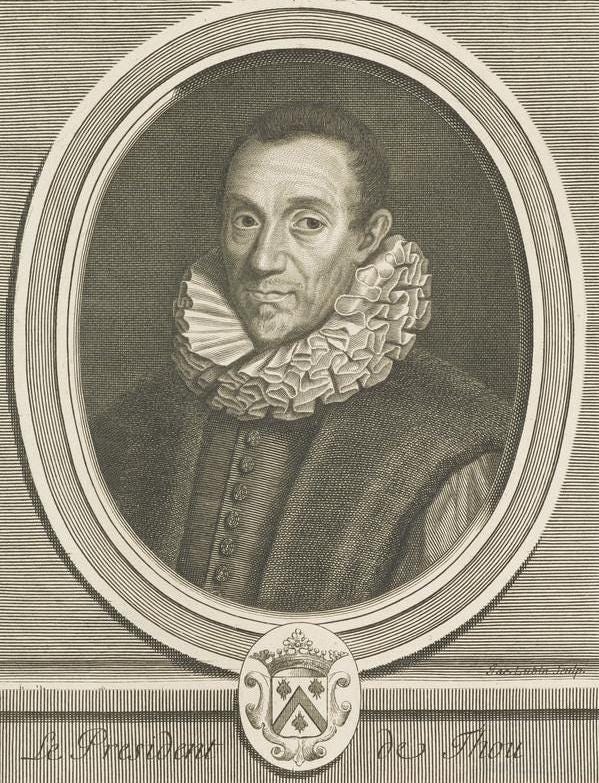[The first page of a 1581 reprint of Barthélemy de Chasseneuz’s Consilium Primum, a legal manual on how to try and excommunicate animals originally published in 1531.]
It is said that Bartholomew Chassenée, a distinguished French jurist of the sixteenth century (born at Issy-l’Evêque in 1480), made his reputation at the bar as counsel for some rats, which had been put on trial before the ecclesiastical court of Autun on the charge of having feloniously eaten up and wantonly destroyed the barley-crop of that province.
Edward Payson Evans, The Criminal Prosecution and Capital Punishment of Animals (1906), p. 18.
The rats had gotten into the barley and had a feast. A feast for the rats was catastrophe for the people of Burgundy, for a lost harvest surely spelled hardship for all and starvation for some. The peasants were furious and furious peasants made the gentry and clerics nervous. The whole regions risked famine, disorder, riots, and perhaps even rebellion. And there were whispers that something still more sinister was afoot: the rats were not merely hungry—rats are always hungry—but had been sent by an evil will to bring calamity and chaos. Were dark forces at work?
The town fathers agreed that something needed to be done about the damned rats. In 1522, they put the rats on trial before an ecclesiastical court in the city of Autun. The rats were charged with the theft and destruction of the barley harvest, and the Bishop’s vicar requested that they be excommunicated and anathematized. And that court likely would have convicted the rats had it not been for the brilliant legal maneuvers of the man they appointed to defend the rats, Barthélemy de Chasseneuz. Chasseneuz’s defense of the rats earned him fame throughout France, launching him into his role as one of the leading French jurists of the 16th century.
Or did it? Chasseneuz is a real figure from 16th century French history, a renowned jurist who sat not only on the highest courts in Paris, Burgundy, and Provencal, but who also authored a number of influential legal tracts, including one on the propriety of trying and excommunicating animals. But the tale of his rat trial, like many other animal trials from the period, comes to us through fragmented and somewhat contradictory sources—historians quarreling with historians over the course of decades and eventually centuries. Although the trial is frequently recounted as an event that “actually took place,” as one contemporary legal scholar confidently asserts, there is, in fact, scant evidence for that confidence. We have, then, a historical mystery many centuries in the making that will require some serious forensic historiography.
In this issue of Strong Paw, we’ll sleuth the mysterious trial of Autun’s demonic rats, as well as Chasseneuz’s clever defense. The story, if it is true, is a fascinating one. And, if it is false, it all the more fascinating. We have much to learn—about the relationship between legal orders and animals then and now, as well as about how scholars have renewed the distant legal spectacles of the medieval period as a way to explore, often unaware, the politics of their own.
I. Animal Trials, Then and Now
I first learned about Chasseneuz’s rats when I was researching an unusual cultural spectacle once common in small towns across the United States in the 1920s. Scores of communities had hosted a public event called “The Trial of the Scrub Sire” in which an actual bull (or sometimes cock or boar) was put on trial before a judge and jury for the crime of hereditary inferiority. If the bull was convicted, it would be sentenced to death (and sometimes even barbecued and fed to the audience).
The trials were part of a larger program of the United States Department of Agriculture called the “Better Sires—Better Stock” Campaign that was designed to encourage American farmers to only use “purebred” sires for stud. The flip-side of using purebred sires exclusively was that the USDA also wanted to dissuade farmers from using so-called “scrub” bulls for stud and, in fact, to butcher them and use them for meat instead—what the USDA termed a program of “scrub eradication.”
Enter the “Trial of the Scrub Sire.” The USDA encouraged county extension agents around the country to conduct the trials to better dramatize the benefits of pure-breeding, and they circulated a script for the trial. County extension agents, in turn, recruited members of the local bar, including judges and prosecutors, to perform in the trial. It made quite a spectacle. Newspapers reported audiences of thousands of people attending the trials and the subsequent funeral parades for the bull that often followed. In the article, I interpreted these events in light of the rising tide of eugenics in 1920s America, with the trials educating attendees about both the technical aspects of livestock breeding and the capacities of the state to effectively govern the reproduction of life and value. The research wound up being the basis of an article I published in the Journal of American History last year, and the research also generated an episode of RadioLab and this recent article by my friend Barry Yeoman in Duke Magazine. Barry’s article is spectacular, and it also has truly lovely original artwork inspired by the trials.
[The cover art inspired by my research.]
The earliest version of my article briefly connected some of the operative logics in the “Trial of the Scrub Sire” to the practice of anathematizing pestilent animals in Europe of the Late Middle Ages and Early Modern Period. In researching that, I discovered not only the story of Chasseneuz’s rats, but the whole veritable cottage industry of popular retellings of it. The story seems to grab modern attention not only because it dovetails with our own popular prejudices about the superstitious and irrational nature of premodern societies, but also because the story involves the universal archetype of the shyster lawyer. Whatever fame Chasseneuz gained in his own lifetime from the trial of rats, it secured him enough notoriety in our day that he was portrayed by Colin Firth in a film in which a pig is framed for murder by a serial killer. (No, I’m not making that up). I was fascinated—not only with the story, but with the story of the story.
[Colin Firth played a 16th century French jurist inspired by Chasseneuz who goes from village to village solving crimes and defending animals in 1994’s The Advocate (called Hour of the Pig in the UK). It’s terrible!]
II. The Town of Autun
The town of Autun is nestled in the hills between the Loire and the Saône about 150 miles to the Southeast of Paris. It straddles a river called the Arroux, which is a tributary of the Loire, and it lies to the southeast of a rugged stretch of low, forested mountains known as the Morvan. Much of the Morvan is now a nature preserve but, in the 16th century, it was primarily used to range livestock. Although Autun sits in the heart of Burgundy’s rich wine country, the soil immediately around the town is not suitable for viticulture and was used mostly for grain cultivation, with barley and wheat the chief crops.
[Burgundy as it is today.]
Autun was established by the Romans during the reign of Augustus, and, under Roman rule, Augustodunum, as they named it, had been a bustling administrative and trade center. After the Romans, it followed a slow decline as a population center. However, the region remained agriculturally productive, which made it a base of power for Burgundian Kings and later Dukes. And although the rulers of Burgundy kept their capital in Dijon, the Bishopric was based in Autun and that guaranteed the town’s continued political and religious significance. The church’s presence there also meant that, at least through the end of antiquity, Autun was still a renowned center of learning, known for its schools of rhetoric, while its favorable location between the two major rivers sustained its status as a hub of commerce.
The Bishop of Autun was based in the town’s magnificent cathedral and it is there that rat trial would have been conducted. The cathedral was not consecrated until the 12th century and it was actually Autun’s second cathedral. Autun’s first cathedral was built sometime around the 5th century and it had been dedicated to St. Nazarius, an obscure early Christian martyr. Near the turn of the 11th century, the town sought the relics of Lazarus, the man whom Jesus reportedly raised from the dead in Bethany. Alas, the Bishopric of Autun confused that Lazarus with St. Lazarus of Aix, a 5th century Provençal Bishop, and received the less notable Lazarus’s remains in error. (Hopefully, they did not overpay.) The mistake proved to be a source of costly excitement for the community. Soon Autun was flooded with confused pilgrims praying to the wrong Lazarus. Pilgrims were a mixed bag. They needed to be fed and housed, but the ability to draw them tended to be a source of local pride and it usually got the aristocracy to open their purses. The Bishop made the case that the old cathedral was now too small, and, so, they built a new one. The new cathedral was a grand Romanesque structure, its magnificent friezes and tympanums sculpted by the influential master Gislebertus. Indeed, it was impressive enough that the Dukes of Burgundy decided to use it as the family chapel.
[The Cathedral of Saint Lazarus in Autun.]
The Dukes of Burgundy certainly needed a grand chapel. In the 14th and 15th centuries, they were uniformly men on the make. In 1363, King John II had given Burgundy to his youngest son, Philip the Bold, as a reward for his battlefield exploits during the Hundred Years War, thus establishing a cadet branch of the House of Valois in Dijon. Subsequent Dukes built up the Burgundy-Valois’s holdings in the neighboring Low Countries, transforming their cadet branch into a rival of the main branch. Philip the Bold’s great-grandson, Charles the Bold, continued the policy of territorial expansion and openly challenged the Valois King. But he also found himself embroiled in a conflict with the Swiss. He raised an army, as one does, and met a humiliating defeat at Grandson. He then raised another army and was defeated again by the Swiss at Morat. And because Charles was bold but apparently not especially competent, he raised a third army and marched on Nancy in late 1476. The Swiss gruesomely slaughtered him there and his naked corpse was gnawed on by wolves. Yikes! Charles is also known as Charles the Reckless. He left no son, so the French King swooped in and annexed the Duchy, extinguishing the cadet Valois branch. This is all to say that while Autun was not a seat of power, neither was it far from power and the grand machinations of the French ancien regime. Burgundy was rich land, and the Dukes had left many powerful vassals and allies.
It was fertile ground for a talented and precocious young man such as Chasseneuz. He was born in Issy-l'Évêque, a small town not far from Autun, around 1480 and he began to study law at the University of Dole at the age of 15 before moving on to the University of Poitiers in 1496. From there, he went to the University of Pavia, arriving just in time for Louis XII and his lieutenant, Charles of Amboise, to seize the Duchy of Milan from Ludvico Sforza. At the tender age of 21, Chasseneuz became an official in Duchy’s government, a post he held even as he continued his studies at Pavia. He received his Doctorate from Pavia in 1502, and continued as an officer until 1506, when he reported fleeing an outbreak of the plague in such haste that he left his books in Italy. Regardless, he returned to his family in Burgundy, married, and, then, after failing to secure a position in Paris, began to practice law in Autun. His studies in Italy gave him unusual command of Roman Law, which was, at this moment in French legal history, a great asset and made him a formidable foe in any courtroom. He lectured before Francis I when he visited Autun in 1521 and impressed him enough that the King invited him to join his court as an advisor. Chesseneuz declined, fearing he could not stand the travel it would entail. Chesseneuz seems to have preferred the more staid life of a learned jurist over that of a courtly schemer. He published a well received commentary on the customary laws of Burgundy in 1517, and the King elevated him to the Dijon high court in 1525. He was briefly placed on the Parisian high court in 1531, but then was promoted to the chief judge of the highest court in Provencal, a position he assumed in 1532 and continued until his death in 1541.
And so, if rats had devastated a harvest in 1522 and a trial had ensued, Chasseneuz would have been in residence in Autun at the time. He also would have been available and well suited to offer the rats a vigorous defense. As peculiar as a trial of rats may seem to us today, it was far from alien to the legal and religious customs of sixteenth century Burgundy.
III. Bugs, Beasts, and Barristers
If Chasseneuz himself is to be believed, the people of Autun were no strangers to animal trials. Chasseneuz described a trial of slugs hosted in Autun in 1488 in one of his books, while other sources record trials of pestilent creatures up and down the Saône valley—in Lyon, Macon, Beaujeau, and Dijon—in the half century before the alleged trial of 1522. The exact purposes of these trials, if they happened at all, is complicated and we’ll return to that question later, but we should begin by relating them to the broader political and social unrest that the region had undergone in the prior two centuries.
As I have noted, Burgundy had been at the center of a struggle between the French crown and its powerful rivals, events that had coincided with a period of general instability historians sometime refer to as the “crisis” of the Late Middle Ages. France, like Europe more broadly, was ravaged by war, famine, and plague in the 14th and 15th centuries. The French crown sought to pay for its protracted conflict with England during the Hundred Years War by levying taxes on its many estates. To satisfy those taxes, the nobility, in turn, squeezed landed peasants for rents, a process that worked in parallel to the early phases of agricultural enclosure. This, in turn, contributed to a series of popular revolts in France and around Europe that lasted until the middle of the sixteenth century. Although Philip the Bold helped to suppress the Harelle rebellion of 1382 in Normandy and Paris, Burgundy itself was spared the worst of the popular revolts, in part, because of its relative independence: the King had no power to directly levy taxes on the Duchy. But the King’s annexation of Burgundy with the death of Charles the Bold altered that situation and surely put the gentry on edge about popular unrest. Whether pestilent animals were merely scapegoats for the nobility or whether the trials were an organic expression of peasant fury at ruined harvests is difficult to tell and perhaps it was both.
The legal basis for such trials was, in the best of times, something of a muddle, but the circumstances in Autun in 1522 are made more confusing by the jumble that was French law in the period. Frankish customary law still held sway in the North, which meant that courts decided disputes largely through recourse to tradition rather than written code and they were generally less bound by royal decrees. In the South, by contrast, courts claimed a loose but not binding allegiance to Roman law, though this entailed a mixture of custom, written codes, canon law, and legal commentaries, with different communities coming to strikingly different conclusions about what Roman law demanded. Royal decrees theoretically held more sway in such a system. The consolidation and growing power of the French monarchy, often at the expense of the Church as a rival power, resulted in codifications of customary law throughout all of France, a process that began in the 14th century but would continue for centuries. In Burgundy, Roman law featured heavily in that process of codification.
Meanwhile, ecclesiastical courts organized by the Church still operated alongside secular courts of the laity that answered to the King and nobility. Most conventional and common legal questions, such as property disputes or assault, did not require an ecclesiastical court, although ecclesiastical courts were sometimes convened for those purposes. Religious conflicts, by contrast, required an ecclesiastical court. The differing capacities of secular and church authorities dictated that ecclesiastical courts could not seize and hold defendants for trial. The scant infrastructure for imprisonment was wielded by and for the laity, and ecclesiastical courts instead “summoned” their defendants. If a defendant refused to appear, they were tried in absentia. Ecclesiastical courts did not impose capital sentences, and therefore the most severe punishment for an ecclesiastical crime was excommunication. (They did, however, give convicted persons over to secular authorities after trial for punishment and those punishments, determined by the crown or its representatives, could include execution.)
[A 19th century illustration of the trial of a murderous pig.]
Europeans had been trying animals for various crimes since at least antiquity. Edward Payson Evans compiled a list of 191 prosecutions in his treatise, The Criminal Prosecution and Capital Punishment of Animals (1906), a text we will return to later. Some of the cases may have been apocryphal, but the underlying phenomena were common enough that even Thomas Aquinas commented on it. (He was not a fan.) In any case, according to Evans, they tried moles in the Valley of Aosta in 824, locusts in Campagna in 886, horseflies in Mayence in 1121, and eels in Lausanne in 1225. They prosecuted a bull in Moiey-le-Temple in 1314, a pig in Caen in 1356, a horse in Dijon in 1389, and a goat in Paris in 1482. The people of Falaise famously tried and publicly executed a sow in 1386 for eating a baby, while, in Marseille, they allegedly prosecuted dolphins in 1596. According to Evans and the authorities he cites, animal trials were common events in Europe—particularly in the Low Countries, Eastern France, Western Germany, and Switzerland—until at least the 18th century when they grew progressively more rare.
Although the prosecuted animals were varied, they tended to fall into two major types. First, there were trials of domestic animals for particular and specific crimes, such as the sow that ate the baby. In these cases, domestic animals were essentially treated as members of a household, which meant they could be tried by secular courts using many of the same evidentiary burdens and procedures that applied to human defendants. But to do so, courts had to navigate the dual status of domestic animals as criminal agents and as valued property. For example, if an ox trampled his driver, killing him, a successful prosecution for murder would mean the ox’s execution. An ox was a valuable thing, and such a scenario would impose a double penalty on the surviving family: the death of the driver and the destruction of a valuable piece of property. In practice, trials of domestic animals tended to deal with the specific circumstances where an animal had injured someone who was outside the family and had no relationship to the animal as property, such as a neighbor or laborer. Still, the destruction and seizure of valuable animal property was a serious penalty, so these trials usually required evidence of a particular crime by a particular animal. If one animal in a herd was criminal, there needed to be testimony about which animal it was, since authorities would be unlikely to execute the whole herd. In one case, where two herds of pigs had trampled a man to death, three pigs and a sow were convicted, but the rest of the herds were pardoned.
Meanwhile, there was another type of trial directed at wild and pestilent animals, such as the locusts of Campagna. Weevils, caterpillars, and vermin wrought far more havoc for farmers than misbehaving livestock, ruining crops and fouling granaries. A single sow could eat your baby, but a swarm of beetles could bring ruin and poverty to an entire community. But no one owned a swarm of beetles and, moreover, it was difficult to prove any particular beetle had done the eating. This meant that pest animals were poorly fitted to be tried by secular courts. Ecclesiastical courts, however, frequently dealt with heresies and had legal instruments available to punish large bodies of actors charged with vague and non-particularized crimes. Their main legal instrument, in this regard, was “minor excommunication,” or the restriction of access to the Eucharist and church services. Excommunication was an imperfect weapon to wield against locusts and weevils, of course, since such creatures were not eligible to receive the Eucharists in the first place and rarely attended mass. As a result, ecclesiastical courts chose an associated but graver theological weapon: the anathema.
Anathema comes from the ancient Greek for “the thing held up or displayed.” In ancient Greek culture, the term was used to describe temple offerings that were “held up” to be seen by a god. In times of war, the offering in question might belong to a vanquished enemy—a weapon, shield, or a head, say—and, over time, the term became attached to this specific kind of display. As a result, the meaning of the term drifted to a ritual or symbolic display that demonstrated the might of your deity and that deity’s ability to smite your enemies. To be anathemetized entailed the threat of winding up as the head that was being “held up or displayed”—the thing cursed and bound for destruction. The concept journeyed to Roman and then Early Christian cultures, where it became attached to the specific smiting capacities of the Christian deity (denoted by the addition of the Aramaic word maranatha or “Our Lord”), a smiting that carried eternal damnation. In other words, anathema was a ritualized curse that frequently accompanied excommunication, but was somewhat larger than that. You could anathematize a horde of unbaptized barbarians. You could also anathematize a table, building, or swarm of locusts. In doing so, religious authorities practiced what was sometimes called “major excommunication,” which meant being permanently separated not only from the Eucharist and religious services, but also being cut off from the body of the faithful and being expelled entirely from Christian society. (The Church abolished the distinction between minor and major excommunications and purged anathema from Canon Law in the 20th century.)
In short, to try a host of verminous rats for spoiling a barley harvest, a trial would need to be held before an ecclesiastical court and, if the rats were convicted, they would be anathematized. And, so, if Evans is to be believed, this is precisely what transpired in Autun in 1522.
IV. The Trial
Evans tells it like this.
The ecclesiastical court convened in Autun and the Bishop’s vicar drew up an indictment. It was alleged that the criminal rodents had, according to Evans, “feloniously eaten-up and wantonly destroyed the barley-crop.” The court set a date for the the trial to be heard and issued a summons to the defendants to appear lest they be tried in absentia.
When the appointed day came, you will not be surprised to learn that the rats refused the summons and none appeared before the court. (We can suppose that some may have been hiding elsewhere in the cathedral or even passed unnoticed through the trial chamber, but, at the least, they appeared to pay the proceedings no mind and didn’t stay to testify.) Given that the guilt of the defendants was unanimously assumed, one imagines that the court was prepared to convict and commence with the anathematization. But then Chasseneuz presented a motion. Chasseneuz noted that the rats of the province were widely dispersed and they resided in villages that dotted the countryside from the Morvan to the Saône. No single announcement could have reached all these locations, nor had sufficient time transpired to permit such a diverse population of rodents to make the journey to Autun. To try the rats in absentia without posting adequate notice was not only unfair, but it was in clear violation of both customary precedent and Roman Law. For the trial to proceed, Chasseneuz ventured the court would need to make a more robust effort to advertise the trial. The court agreed. And, so, for many weeks, the details of the charges and the coming trial were announced from the pulpit at every church in the Bishopric.
The date of the rescheduled trial approached and, once again, the rats did not appear. Before the court could again try the rats in absentia and anathematize them, Chasseneuz raised another objection. If a court’s summons required a defendant to make a dangerous journey—to traverse a hostile territory or the holdings of an enemy, for instance—the defendant could refuse the summons until such time as the court provided them with safe passage, usually in the form of an armed escort. Chasseneuz noted that the rats had foes in every village in the province, mortal enemies who waited vigilantly to pounce. Literally. Chasseneuz was talking about cats. If the court expected the rats to make the journey to Autun, the rats needed to be guaranteed protection from the cats.
[A 19th century imagining of the massacre of the Vaudois by Gustave Dore.]
It was unclear to Evans if the trial was simply terminated at this point or if the rats were formally acquitted. Most modern sources assume that Chasseneuz’s legal maneuverings at least prevented the rats from being anathematized. And all of this, in turn, established Chasseneuz’s reputation for brilliant legal maneuvers throughout the whole of France. Later in life, Evans reported, when Chasseneuz was the high judge of the court in Provencal, a friend begged him to show leniency to a group of Vaudois heretics that the court had ruled against. The friend asserted that the heretics had not been given an adequate opportunity to respond to the summons of the court and then to defend themselves. He cited to Chasseneuz his own defense of the rats as precedent for giving the heretics adequate time to respond to the summons. Chasseneuz was apparently so moved by this argument that he delayed the suppression of the heretics, although it ultimately did them little good. Chasseneuz died in 1541 and the Vaudois heretics were massacred in Mérindol in 1545.
That is, of course, if Evans is to be believed. That’s quite a big if.
V. Scholars, They Disagree
Most scholars regard the trial as a real historical event and, more or less, confirm Evans’s report of it. This includes some legal scholars, such as Piers Bierne and Paul Schiff Berman, who are not specialists on France of the period. Berman, for example, writes, “Strange as it may sound, this ‘tale’ is not really a tale at all, for the trial described above actually took place.” Ironically, Berman levels this claim in an essay arguing that we should imaginatively reconstruct the possible social functions of seemingly irrational and implausible legal events. Berman’s certainty of the historicity of the event is, in turn, mostly supported by the work of at least one eminent legal historian, Esther Cohen, whose work on animal trials is essential reading on the topic even after almost four decades. And, full disclosure, I also uncritically accepted this story as true as recently as a year or so ago.
However, at least one historian has an intriguing dissenting view worth examining. Professor Sara McDougall is an expert on medieval French legal history. Although I’m not one, I do know of and think highly of some of McDougall’s work on law and sex during the medieval period. McDougall hasn’t (to my knowledge) published on animal trials specifically, but she has written extensively about other elements of French legal history during the period, so I was naturally intrigued when I ran across her comments in a Slate article on animal trials that seemed to suggest the tale of Chasseneuz’s rats were fabricated:
The main issue with our understanding of the strange practice, according to Sara McDougall, associate professor at the John Jay College of Criminal Justice, is the sourcing. “The sources are 19th-century scholars who didn’t bother to give a whole lot of explicit information on where they found the stuff,” she says, “With a lot of the medieval ones, we know that some of them were either made up or they were textbook cases that were kind of a way to keep students from falling asleep.” In an even stranger reasoning for a fake animal court story, McDougall says that one of the most famous cases of beasts on trial, involving a bunch of rats, was “completely made up just to defame the lawyer who supposedly defended the rats.”
The article doesn’t specify which defamatory rats McDougall is referring to, but, as you’ll see from the context provided in a bit, they are almost certainly Chasseneuz’s. Which sparked my thinking: How did I know the story of the rats had happened at all? I had, at the time, already read Evans’s account and contemporary historians such as Cohen. Did I trust Evans too much? If, as McDougall suggested, Evans had built his account on credulous nineteenth century scholars who treated malicious gossip as fact, perhaps I was spreading a long-simmering bit of libel against Chasseneuz?
Since Evans is the source that most scholars cite, that is where we must start. Edward Payson Evans (1831-1917) was an American academic and language specialist with an interest in animals. He taught for stretches at John Carroll University and the University of Michigan until 1880, before leaving the academy to write and study in Munich, where he remained for most of the rest of his life. The Criminal Prosecution and Capital Punishment of Animals was published in 1906, but Evans published an earlier version of the material in the Atlantic Monthly in 1884, “Bugs and Beasts Before the Law.” In both texts, Evans offered a summary that roughly matches what I have written above and repeated the claim that Chasseneuz’s later fame stemmed from the rat trial. He omitted any specific year for the rat trial, but, in the chart he provided after the main part of his text, he logged it as 1522. Evans had three main sources for his claims: (1) A text authored by Chasseneuz himself, Consilium Primum (1531); (2) A text authored by an early nineteenth century French intellectual and writer, Edme-Théodore Bourg (who published under the name Saint-Edme), Dictionnaire de la pénalité dans toutes les parties du monde (1828); (3) A text authored by an early nineteenth century French jurist and law professor, Jacques Saint-Prix-Berriat, Rapport Apport et Recherches sur les Procès et Jugemens Relatifs aux Animaux (1829).
Given that it is a legal manual on how to try and excommunicate animals, one would expect to find direct evidence of Chasseneuz’s rat trials in Consilium Primum. However, it is not mentioned there. In 1531, Chasseneuz began publishing a series of legal commentaries called the Consilia that were intended as practical guides for conducting legal proceedings. Consilium Primum was the first of these, and it explained both the basis and procedure for animal trials for the benefit of the people of Beaune who wanted to try some pestilent beetles. Chasseneuz’s answer was unambiguous: it was legally proper to try and excommunicate animals—he cited an exhaustive list of precedents, some historical and some legendary—provided that one followed the correct and established procedure to do so. In the course of this discussion, Chasseneuz mentioned that a number of trials of animals had been held in and around Autun, beginning with the aforementioned trial of slugs in 1488 and continuing until the time when he was writing, and that those trials had included at some point a prosecution of rats. While Chasseneuz offered specific dates for three other trials in or around Autun, he omitted the date for the trial of rats. If the trial happened in 1522, Consilium Primum offered no evidence for it, much less for Chasseneuz’s involvement.
[Edme-Théodore Bourg, 1785-1852]
In fact, the 1522 date comes from Bourg, although it seems Evans was either careless or took some liberty with what Bourg wrote. Bourg’s Dictionnaire was essentially an extensive historical encyclopedia of legal punishments, and Chasseneuz’s rats appeared in an entry on animals. In it, Bourg stated that pests destroyed the crops around Autun between 1522 and 1530 and, then, he recounted the details of the trial. Bourg cited as his source Auguste de Thou, a sixteenth century French aristocrat and historian who we will turn to in a moment, and he offered some vivid details, including directly quoting a stirring speech from Chesseneuz’s defense:
“Was there anything more unjust,” he said, “than these general proscriptions, which strike families en masse, which punish the child for his parent’s crime, which attack without distinction those who because of youth or senility are incapable of the crimes?”
Powerful stuff! Again, Bourg gave a range of years, purportedly from Thou, but did not specify 1522, and Evans transformed this to 1522 in his list, which appears to be why most historians use the 1522 date. Meanwhile, Bourg either did not know about, or chose not to mention, that the events he was recounting made no appearance in Chasseneuz’s own writings on the topic, and he also omitted the context of Thou’s description of the events, except to say that it was in an “introduction to the history of the massacres of the Vaudois.”
[Jacques Berriat-Saint-Prix, 1765-1849.]
By contrast, absence of evidence for the rat trials was, in fact, a major point addressed by Saint-Prix-Berriat’s Recherches, the third source Evans used. Saint-Prix-Berriat was born in 1769 and had been a fervent supporter of the Revolution and, then, of Napoleon. In the early 1820s, he was asked to scrutinize the research of another scholar, named Lejeune, for the Société des Antiquaires de France. Lejeune had gathered primary documents describing animal trials, including Consilium Primum, some of which had already been published by 1820. Saint-Prix-Berriat conducted his review and presented it to the Society and it was published in 1829 as Recherches. It was a scholarly work, unlike Bourg’s more popular tract, and Saint-Prix-Berriat took pains not to embellish the details of the story and to present it with as little sensationalism as possible. Saint-Prix-Berriat struggled to explain why the rat trials were absent from the Consilium Primum. He argued Chasseneuz was being considered for higher judicial posts at the time of its writing, and, as a result, may have considered it boastful and imprudent to include details of his famous rat trials. Moreover, Saint-Prix-Berriat judged it significant that, while Chasseneuz included dates for the other animal trials around Autun, he left out the date of the rat trial, which Saint-Prix-Berriat inferred as consistent with an effort by Chasseneuz to conceal his own involvement in the trial.
Saint-Prix-Berriat focused on the absence of the rat trials in the Consilium Primum because, in the eighteenth century, the fact of the trials had been widely disputed, most notably by the French magistrate and legal historian Jean Bouhier. Bouhier published a history of Burgundy’s customary law in the 1742, Les Coutumes du duché de Bourgogne, and he included a lengthy entry on Chasseneuz. He directly dismissed the fact of the trials, attacking two texts that included accounts of the trials as “overly credulous” and filled with “legend.” Bouhier was specifically referring to the books Histoire des vrays Tesmoins de la vérité De L'Euangile (1570), usually called the Martyrology of the Protestants, by the French Protestant attorney Jean Crispin and the first volume of Auguste de Thou’s Histoire universelle depuis (1604). Although most later authors would be more likely to read Thou’s work, it seems that Thou, in turn, was actually repeating the story that Crispin gave in the Martyrology. (It bears mention that modern historians do not regard the Martyrology as a reliable historical account.) That entire story was centered on the massacres of the Vaudois and, as Bouhier noted, contained at least one obvious error: it incorrectly claimed that Chasseneuz had written about the rat trials in another of his books, Catalogus Gloriae mundi (1529).
In any case, in Histoire universelle, Thou reported that an old friend of Chasseneuz had come to him when he was the high judge in Provencal and was considering an order the court had made against the Vaudois. The friend argued that the suppression of the Vaudois was too hasty and that the Vaudois should have more time to plead before the court. In pursuing his argument, he forced Chasseneuz “to oppose yourself to yourself” by citing Chasseneuz’s robust defense of the rights of the rats, in particular, to have ample time to travel to court. The friend asks Chasseneuz, “Will you believe that the condition of so many poor people, of whom you are the judge, will be worse than that of the vile animals you defended?” In the story, Chasseneuz is so moved he delays executing the court’s order, but then he shortly expires.
[August de Thou, 1553-1617.]
Bouhier mockingly called this a “beau conte,” or beautiful tale, and it does seem rather on the nose. Bouhier alleged that Crispin “took for a truth, a joke, which he had heard, without deigning to inquire more exactly,” and Bouhier judged Thou harshly for including it, reasoning that Thou should have known better. Bouhier’s underlying point was that the rat trials, at least as Thou and Crispin gave it, was hearsay. There was no direct account of the rat trials themselves, but instead a report of a conversation between Chasseneuz and his old friend (Bouhier named the friend as Jacques de Rainaud, Sieur d’Allenc) where neither of the people who reported the conversation were actually alive at the time of the trail to witness it.
Saint-Prix-Berriat disputed Bouhier’s conclusions and held that the trials had, in fact, occurred as it was recounted in Thou. He argued that Bouhier could not dismiss Thou’s credibility in the case of the rats, as Bouhier did, if he also was going to rely on Thou extensively and uncritically elsewhere in Coutumes. Thou was either a reliable source or he was not; Bouhier could not have it both ways. Moreover, Saint-Prix-Berriat noted that, while Thou was not a historical contemporary of Chasseneuz’s, his father and grandfather, both jurists, had been, and, moreover, Thou’s grandfather had briefly been Chasseneuz’s colleague on the Paris court and would have known him. Saint-Prix-Berriat judged it unlikely that Thou would casually and credulously report on Chasseneuz’s doings, since he had so many personal connections to the man and could have easily confirmed the story through those connections.
It is impossible to settle this argument from so many centuries distance. Bouhier was correct that the evidentiary basis for the trial is quite thin and that it has been distorted and embellished over time. The original sources are second-hand reports of a conversation between Chasseneuz and a friend that happened many years after when the trial is said to have occurred. The sequence of reports requires not only that Crispin and Thou received an accurate account of a conversation between Chasseneuz and the friend, but also that Chasseneuz and the friend remembered the trial clearly in 1541. And Bourg’s quotation above is also a clear example of an embellishment. It does not appear in Thou, the only work that Bourg cited, which means that Bourg either invented it from whole cloth or that he snagged it from another source that he did not cite and I have not reviewed. The year 1522 also appears to be an added detail that has no real basis. It comes from the range of dates Bourg gave, and because it was absent altogether from Thou, it was a range that was not supported by the text Bourg cited. Moreover, Bourg’s range doesn’t fit Chasseneuz’s career: Chasseneuz was judge in the Dijon court from 1525 on and could not have represented the rats during the later years in the range Bourg provides. For skeptics such as Bouhier and McDougall, this is all good ammunition. I don’t know that it means that the original story from Thou was intended to defame Chasseneuz, as McDougall suggests, since the story Thou gave arguably casts Chasseneuz in a flattering light. But, at the very least, the story should be taken with a grain of salt large enough to temper an assertion such as Berman’s that the trial “actually took place.”
And, while this is all true, some context is also appropriate. The larger historical record shows that the trial and excommunications of animals, including rats, did occur and that the trials were sometimes derailed by procedural objections. Chasseneuz was involved in at least one such trial, since the Consilium Primum is his consultation on a trial of beetles in Beaune. It would be perfectly consistent with Chasseneuz’s writings and life if he had been appointed to defend rats from excommunication in Autun—there is nothing fanciful or implausible about that. He fervently believed you could try rats, and he believed that such a trial needed to adhere strictly to procedure, and he was a prominent, capable attorney in Autun for nearly two decades: means, motive, opportunity. The details of the pleas are harder to adjudicate, since Chasseneuz’s lawyerly chicanery makes for a much better story. We can imagine him doing it, but we also probably want to imagine him doing it. But this sort of embellishment is also enormously common in the sources of that period. If historians excluded every source that reported hearsay as fact or that failed to cite its own sources, we would have very few sources to work from, which is precisely why Bouhier only disregards Thou in this one case but uncritically relays what he writes as fact everywhere else.
Nor is this simply a problem for that historical period. The very first issue of Strong Paw was about a quotation—“get big or get out”—the speaking of which has been relayed as fact by some of the most prominent food and agriculture writers of the day. Michael Pollan, Dan Barber, Ted Genoways, Mark Bittman, Wendell Berry, Tom Philpot, and Catherine Friend all report it as historical fact that Earl Butz (and sometimes Ezra Taft Benson) said it, but the evidentiary record is as thin for that quotation as it is for Chasseneuz’s rats. And, ultimately, we must then ask: why do we want to believe or disbelieve that such a trial occurred? And why has the historicity of this event remained a lurid object of scholarly desire unsatisfied now over five centuries?
VI. The Mirror
Evans was a committed and early advocate of animal rights. The Criminal Prosecution and Capital Punishment of Animals is slightly removed from this context, but one can easily imagine this political desire working through its pages. Perhaps Evans wanted to believe in Chasseneuz’s rats precisely because he was invested in the idea that the mistreatment of animals was a relic of barbarism. For Evans, a more enlightened legal order would protect animals from violence, suffering, and mistreatment. And such an enlightened legal order was precisely what he wanted to constitute through his writing.
Evans found a suitable ally in Saint-Prix-Berriat, the revolutionary and then stalwart supporter of the Napoleonic reforms of the French legal system. For Saint-Prix-Berriat, Chasseneuz’s dogmatic support for the trials of animals would, indeed, have been par for the course for the irrationality and unreason of that age, when squabbling aristocrats and venal clerics exploited the people of France. And although Saint-Prix-Berriat appears to have been indifferent to the treatment of animals, he was happy to confirm through the details of the trial Chasseneuz as a relic of that strange and superstitious age.
Saint-Prix-Berriat’s disagreement with Bouhier on this count, then, seems overdetermined. Bouhier was a French aristocrat, but also a man of the Enlightenment who claimed Jean le Rond d’Alembert as an admirer. Bouhier seemed to see in Chasseneuz a precursor of his Enlightenment sensibility, a man working through the terrible muddle of French customary law to give a semblance of structure, precedent, reason, and predictability. To confirm, as Chasseneuz had done in the Consilium Primum, that animals could be tried was merely to state what precedent dictated, not to express Chasseneuz’s personal enthusiasm for the idea or to assert his personal involvement in such a trial. This, to Bouhier, was a worldly and erudite attitude to be contrasted with that of the credulous Thou and Crispin.
Meanwhile, although a faithful Catholic, Thou saw himself as a broker of religious peace. When he recounted the mounting religious conflicts of the day in his Histoire universelle depuis, he did so intent on generating reconciliation between the warring religious factions, an approach that led the Church to suppress his book but that also, no doubt, attracted him to Crispin’s tale of Chasseneuz and his friend. Thou was not interested in the trials themselves, much less, like Evans, what the trials told him about how people should treat animals. Those concerns were remote to Thou, significant only in that they showed that the Vaudois were being treated worse than animals. Rather, Thou emphasized that when Chasseneuz was reminded of the arguments of his more idealistic younger self, he was awakened to the wrong being done to the Vaudois heretics.
Today’s legal scholars are mining Chasseneuz’s rats anew to revise Evans’s account. Their interest is not to cast doubt on the historicity of the events—which they mostly do not doubt occurred as Evans recounts them—but, rather, to make the case that the trials of animals preserved a more capacious premodern notion of animal agency. This approach, they assert, could, in turn, be the foundation for the inclusion of animals within our contemporary legal order with limited rights and standing. If the people of Autun could respect the rights of the cursed rats to a fair and timely summons, they pose, why cannot we recognize even more basic rights of animals to live without suffering and duress? I personally do not think this approach will work, but it is a provocative effort.
In all of these instances, Chasseneuz’s rats are summoned—including by myself—in relationship to the world that each of these authors desired yet to make. This is not so much about a source’s “bias,” as undergraduates sometimes complain, nor about the source’s “situated perspective,” as we often teach in history methods classes. Both of these terms relate a text to the world it describes, but they do not relate the historian to the text, nor foreground the range of affects that fortify our narrations. We are careful and cautious in our conclusions, never taking more from a source than it can afford to give. Older generations of historians were credulous and reckless, we say, bankrupting their sources and themselves in the process. Perhaps an exercise such as I have endeavored to conduct will be chastening, reminding us to examine, with honest and open curiosity, the political desires that animate our own writings. I suspect it will not. But for my own part, I would say that historians do not so much see bits of a picture of the truth broken into a thousand pieces so much as historians are attached to the image they see reflected in the fractured shards of a past.

